Barbara Kyle's Blog: The Rest of the Story - Posts Tagged "mary-queen-of-scots"
Did the Queen Murder her Husband?
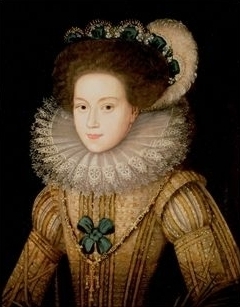
The news stunned Queen Elizabeth I and her court. Her cousin Mary, Queen of Scots had been defeated on the battlefield near Glasgow and fled in terror of being captured. Crossing the border to England she had arrived in Carlisle with nothing but the clothes she stood up in. It was May, 1568.
Mary (that's her on the left) wrote to Elizabeth asking for her support to storm back to Scotland at the head of an army to vanquish her foes. Those foes were led by Mary's half-brother, the Earl of Moray, who just months before had forced her (at knife point, she said) to abdicate. He had also accused her of adultery with the Earl of Bothwell and of conspiring with him to murder her husband, Lord Darnley.
Welcome to the shark-infested world of 16th-century Scottish politics.
Darnley had indeed been murdered the year previously when the house he was staying in near Edinburgh was blown up. It had been undermined with kegs of gunpowder. Charges for masterminding the crime were laid against Bothwell, the tough military man Mary had turned to when her marriage had soured. There had been plenty of gossip that she and Bothwell were lovers. At his trial Bothwell was acquitted, thanks to Mary's support, and three months after Darnley's death she took Bothwell as her husband.
Moray and his followers then accused Mary herself of the murder. They imprisoned her and forced her to abdicate. Mary had lost her kingdom. Bothwell fled to Denmark.
But Mary escaped, raised an army, and met Moray on the Glasgow battlefield. He won. Mary had lost her kingdom for the second time. She was twenty-six.
Arriving in England as a royal refugee, Mary fully expected her cousin Elizabeth's protection and support. Mary was often blind to reality when she had a passionate stake in a situation, and never was she more blind than when she asked for help from Elizabeth. (That's Elizabeth below.)
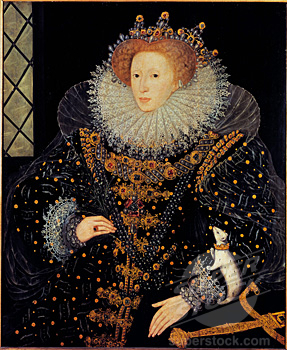
Because Mary's arrival in England created a terrible quandary for Elizabeth. England was Protestant but a large, disgruntled portion of its people were Catholics who believed that Mary, a pious Catholic, should be on the throne instead of Elizabeth, whom they regarded as illegitimate and a heretic. Both queens had Tudor blood. Elizabeth was the granddaughter of the first Tudor monarch, Henry VII; Mary was his great-granddaughter. Elizabeth, unmarried, had no children (she was thirty-five), and Mary had the best claim to succeed her. Elizabeth feared that Mary would be a lightning rod for these disaffected Catholics to rise up to put her on the throne. Mary could expect the backing, too, of the mightiest power in Europe, Catholic Spain.
Elizabeth's councilors were appalled at the thought of Mary moving freely in England to draw Catholics to her cause, and they advised Elizabeth to imprison Mary. Elizabeth recoiled at that, for she took very seriously her cousin's royal status. However, she decided on a way to neutralize Mary. She could not lend her support, even to a queen, if Mary proved to be an adulteress and a murderer. Here's the dead Lord Darnley.
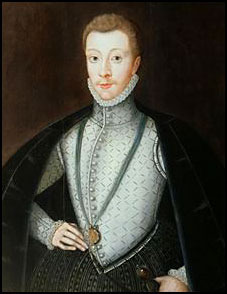
The solution was Machiavellian - and pure Elizabeth. She decided to hold an inquiry into the charges against Mary. In soothing letters to her cousin she assured her that if the charges proved unfounded, as Mary claimed, Elizabeth would wholeheartedly back her in restoring her to her Scottish throne. All of Europe was agog, waiting for the outcome. Elizabeth's tactic was one that modern-day crafters of smear campaigns would appreciate. Dirt, once it is hurled in public, tends to stick. Elizabeth would then be free to uphold her alliance with Moray's Protestant government in Scotland.
It was not called a trial, since English courts had no jurisdiction over foreign rulers, but for all intents and purposes a trial is what it was. Elizabeth set the venue; the inquiry would take place at York. (It would later move to Westminster.) She invited the Earl of Moray to come and argue his case before her commissioners. He eagerly agreed, and set out from Edinburgh with a rookery of lawyers.
Mary was furious. She refused to attend the inquiry, saying that the only way she would appear to answer the charges made by her subjects was if they were brought before her in chains. It was one of her many impetuous decisions that doomed her, for by all accounts she had extraordinary charm and had she attended she might very possibly have won the commissioners' sympathy. Instead, she appointed others to act in her name: Lord Herries and the Bishop of Ross, men staunchly loyal to her.
Elizabeth appointed the Duke of Norfolk to preside. But Norfolk, like just about everyone involved in this intricate piece of political theater, had a hidden agenda. Mary, ever seeking to enhance her power base in England, had made Norfolk an offer he could not resist: marriage. Secretly, in letters, the two formed a marriage plan. For Norfolk it was the brass ring, because Mary had the best claim to be Elizabeth's heir, and if she came to the throne then he, as her husband, would be king. Norfolk, therefore, was secretly predisposed to find Mary innocent.
But then something happened that changed the course of the proceedings, and of history. Moray presented evidence to the English commissioners: eight letters written by Mary to Bothwell while she was married to Darnley. These have become known as the "casket letters," so named because, said Moray, they were found in a small silver casket under a bed in Bothwell's house after he had fled the country.
How convenient, Mary raged. She had good reason to rage, for she only heard about the letters from leaks. Moray had presented them to Elizabeth's commissioners alone, in secret. Mary was not allowed to see the evidence that was to damn her.
And damning it was. The letters were lascivious, the intimate words of a woman to her lover. Worse, they indicated that Mary and Bothwell had indeed been plotting to kill Darnley. News of the letters, carefully leaked, shocked all of Europe. Here's Bothwell.
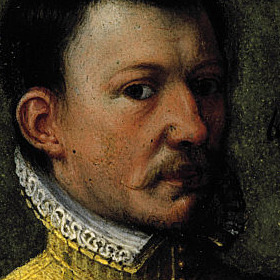
Mary swore to her dying day that the letters were forged. And the fact that she was allowed no rebuttal was such a miscarriage of justice, her furious commissioners withdrew from the inquiry in protest.
Elizabeth gave Mary one last chance to come before the inquiry and defend herself. Mary refused, sure that such a desperate move would be a virtual confession of guilt. But the damage had been done. Mary's reputation was in tatters. Even many of her Catholic followers turned away from her.
Elizabeth was satisfied. She wrapped up the inquiry without even proclaiming a verdict. She didn't have to.
The casket letters no longer exist. Moray took them back to Scotland where they eventually ended up in the possession of Mary's son, James. He became king, and the letters were never seen again.
Mary never regained her freedom. She was kept under house arrest for the next nineteen years. Hers was a comfortable captivity, spent in a series of old castles with a small retinue to serve her, but it was captivity nonetheless. During those nineteen years she plotted ceaselessly to take Elizabeth's crown, and when the last plot in 1586 almost succeeded her complicity was an irrefutable fact. Elizabeth had had enough. Charged with conspiring to murder Elizabeth, Mary's trial took place in October 1586. This time, it was not her reputation that was in jeopardy, it was her life.
That trial was a mere formality, its outcome never in question. Four months later Mary was executed, beheaded at Fotheringhay Castle.
The famous rivalry between these two queens has enthralled the world for over four hundred years. It enthralls us still.
___________________________
The "casket letters" inquiry forms the backdrop of my novel Blood Between Queens.
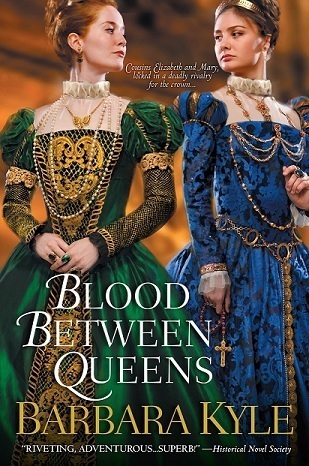
Visit my website www.BarbaraKyle.com
Published on March 13, 2014 18:11
•
Tags:
elizabeth-i, historical-fiction, history, mary-queen-of-scots
The Hinges of History

Game changer. Turning point. We use these terms to describe crucial, pivotal events. In my historical novels I like to call such events the hinges of history.
It's a powerful image: a swinging door. An opening, a closing. Sometimes with a joyful whoosh, sometimes an anxious creak, sometimes a furious slam.
I set my stories at these hinges of history – decisive historical events – to test my characters’ mettle as the doors of change open and close.
My Thornleigh Saga novels follow a middle-class English family's rise through three tumultuous Tudor reigns during which they must make hard choices about loyalty, duty, family, and love.
The Thornleigh family is fictional; I created them. But the dynamic historical events they're passionately involved in are solid, fascinating facts.
 The Thornleigh Saga begins with The Queen’s Lady set in the nerve-jangled court of Henry VIII as he wrenches England away from the Roman Catholic church to divorce Catherine of Aragon and marry Anne Boleyn. Honor Larke and Richard Thornleigh fight to save the church's victims. To get Anne, Henry created a national church - a hinge of history that changed the course of England.
The Thornleigh Saga begins with The Queen’s Lady set in the nerve-jangled court of Henry VIII as he wrenches England away from the Roman Catholic church to divorce Catherine of Aragon and marry Anne Boleyn. Honor Larke and Richard Thornleigh fight to save the church's victims. To get Anne, Henry created a national church - a hinge of history that changed the course of England. When Henry VIII’s bitter daughter, Queen Mary, launches her reign with a vow to annihilate heretics, young Isabel Thornleigh must act quickly to save her family in The King's Daughter. Determined to rescue her father from prison, she entrusts her mission, and herself, to ruthless mercenary Carlos Valverde. But Isabel is also pledged to spy for rebel leader Thomas Wyatt who is bent on overthrowing the Queen. Isabel joins Wyatt's rebellion, a hinge of history that, amazingly, brought the rebel army to the very gates of London.
When Henry VIII’s bitter daughter, Queen Mary, launches her reign with a vow to annihilate heretics, young Isabel Thornleigh must act quickly to save her family in The King's Daughter. Determined to rescue her father from prison, she entrusts her mission, and herself, to ruthless mercenary Carlos Valverde. But Isabel is also pledged to spy for rebel leader Thomas Wyatt who is bent on overthrowing the Queen. Isabel joins Wyatt's rebellion, a hinge of history that, amazingly, brought the rebel army to the very gates of London.  In The Queen’s Captive the hinge of history swings when Henry VIII's daughter, Queen Mary, imprisons her twenty-year-old half-sister Elizabeth in the Tower. The terrified Elizabeth fully expected to be executed. The Thornleighs make it their mission to save her, and in the ensuing national uprising against Mary, Elizabeth learns the hard lessons she will need to become a formidable leader.
In The Queen’s Captive the hinge of history swings when Henry VIII's daughter, Queen Mary, imprisons her twenty-year-old half-sister Elizabeth in the Tower. The terrified Elizabeth fully expected to be executed. The Thornleighs make it their mission to save her, and in the ensuing national uprising against Mary, Elizabeth learns the hard lessons she will need to become a formidable leader.  The Queen’s Gamble is set during the young Queen Elizabeth's fledgling reign. Fearing invasion by the French through Scotland, she sent money to John Knox's Scottish rebels who were fighting their French overlords. Isabel Thornleigh accepts the dangerous mission to secretly take the queen's money to Knox. Eventually, Elizabeth gambled by sending an army north to face the mighty French. Her victory ushered in Knox's Protestant government, swinging a hinge of history that forever changed Scotland.
The Queen’s Gamble is set during the young Queen Elizabeth's fledgling reign. Fearing invasion by the French through Scotland, she sent money to John Knox's Scottish rebels who were fighting their French overlords. Isabel Thornleigh accepts the dangerous mission to secretly take the queen's money to Knox. Eventually, Elizabeth gambled by sending an army north to face the mighty French. Her victory ushered in Knox's Protestant government, swinging a hinge of history that forever changed Scotland.  Blood Between Queens focuses on the hinge of history when Mary, Queen of Scots flees to England to escape her enemies and seeks help from her cousin, Queen Elizabeth. But Mary has set her sights on the English crown, and Elizabeth enlists her most trusted subjects, the Thornleighs, to protect it. Justine, the Thornleighs' ward, pities Mary when Elizabeth holds her royal cousin under house arrest. The crisis splits the Thornleigh family apart, mirroring the deadly rivalry between the two queens that threatened England's very survival.
Blood Between Queens focuses on the hinge of history when Mary, Queen of Scots flees to England to escape her enemies and seeks help from her cousin, Queen Elizabeth. But Mary has set her sights on the English crown, and Elizabeth enlists her most trusted subjects, the Thornleighs, to protect it. Justine, the Thornleighs' ward, pities Mary when Elizabeth holds her royal cousin under house arrest. The crisis splits the Thornleigh family apart, mirroring the deadly rivalry between the two queens that threatened England's very survival.  In my upcoming release, The Queen's Exiles (June 2014) a ragtag band of revolutionaries calling themselves the Sea Beggars challenge the mighty global empire of Spain. Adam Thornleigh and the brave Scottish-born Fenella Doorn join forces with the Sea Beggars, who made history when they captured a port city in the Spanish-occupied Netherlands—and thus began the Dutch War of Independence.
In my upcoming release, The Queen's Exiles (June 2014) a ragtag band of revolutionaries calling themselves the Sea Beggars challenge the mighty global empire of Spain. Adam Thornleigh and the brave Scottish-born Fenella Doorn join forces with the Sea Beggars, who made history when they captured a port city in the Spanish-occupied Netherlands—and thus began the Dutch War of Independence. The hinges of history tested the people who lived in those turbulent times. To this day we can hear echoes of the doors swinging open . . . and the ones slamming shut.
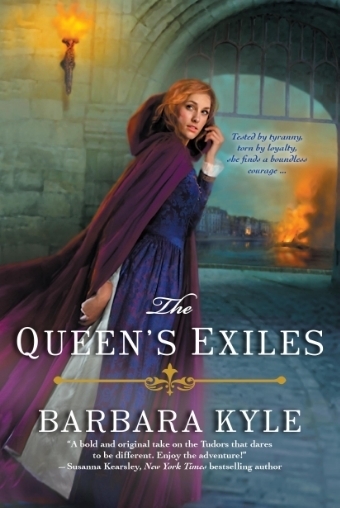
For more about the Thornleigh Saga books, please visit my website: http://www.barbarakyle.com/
***
Published on March 28, 2014 18:10
•
Tags:
elizabeth-i, mary-i, mary-queen-of-scots, thornleigh, thornleighs
Elizabeth and Mary: Leadership Lost and Won
 Should we act from the head or from the heart? In Jane Austen’s terms: from sense or sensibility?
Should we act from the head or from the heart? In Jane Austen’s terms: from sense or sensibility? Two queens epitomize this primal divide.
Elizabeth I of England acted with careful deliberation, keeping her ambitious nobles in line and her kingdom safe from foreign attack during a peaceful reign of over forty years. Her cousin Mary, Queen of Scots followed her passions throughout her seven-year reign, making impetuous decisions that fomented a civil war in which she gambled her kingdom on the battlefield, and lost.
For over four hundred years their story has enthralled the world.
Mary fled to England to escape the Protestant lords who had deposed her, and begged Elizabeth for an army to fight them. But Elizabeth needed Protestant Scotland as a bulwark against possible invasion by Catholic France or Spain, so she kept Mary under house arrest – a captivity, though comfortable, that lasted nineteen years.
While captive, Mary plotted ceaselessly to overthrow Elizabeth and take her crown, and when the last plot almost succeeded, Elizabeth executed her.
The head vs. heart divide marked these two queens’ very different attitudes about leadership. It stemmed partly from their upbringing.

Mary (that's her above) was sent to France at five to join the French king’s family in preparation for marriage to his heir, Francis, and grew up in the most glittering court in Europe, petted and loved by the French royal family. She married Francis when both were in their teens, and when his father died a year later he became king. Queen of France at sixteen, Mary had little to do but please and pamper herself.
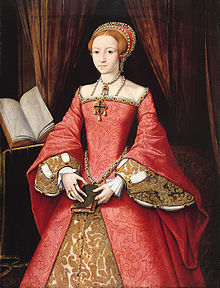
Elizabeth’s childhood, in contrast, was one of uncertainty and fear. (The portrait above shows her in her teens.) Her father, Henry VIII, beheaded her mother, Anne Boleyn, when Elizabeth was three. Then he disinherited Elizabeth. When she was twenty-one her half-sister Mary took the throne and sent Elizabeth to the Tower, where she expected to be executed. But Mary died four years later and Elizabeth became queen. In those perilous years she had learned to watch and wait, and never to act rashly.
It was a lesson Mary, Queen of Scots never learned. When her French royal husband died she returned to Scotland at eighteen to take up her birthright as its queen, and there she fell in love with an English nobleman, Lord Darnley. Despite the disapproval of her councillors, she impulsively married him. Here's Darnley.
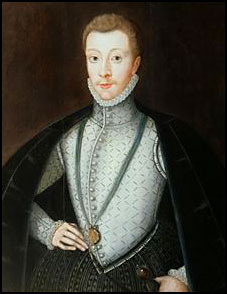
The marriage splintered Mary's nobles into factions, creating a simmering civil war. She bore a son, James, but her marriage quickly soured. She turned to a tough military man, the Earl of Bothwell, and there was gossip they were lovers. Here's Bothwell.
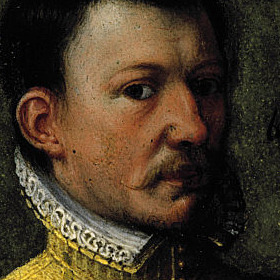
One cold February night the house Darnley was sleeping in was blown up, killing him. Bothwell was accused of Darnley’s murder and stood trial, but was acquitted. Three months later, Mary took Bothwell as her third husband. Her people suspected her of colluding with him to murder Darnley, and turned against her.
Elizabeth, famously, never married. She knew that if she did her husband would be considered king, eclipsing her power and creating warring factions. Her decision to remain single brought her considerable personal anguish. She was heard to say, when Mary’s son was born, that she envied Mary the baby, “while I am barren stock.” But she knew her decision was wise. Elizabeth loved her people, and often said that they were her family. They loved her in return.
Mary is to be pitied, kept captive for nineteen years, then beheaded at Elizabeth’s order. But it was her disastrous, impetuous leadership decisions that led to her downfall.
If peace, prosperity, and international respect are the fruits of successful leadership, the cautious Elizabeth remains one of England’s greatest leaders.
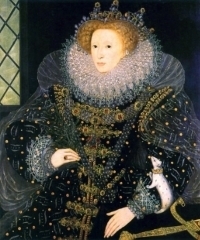
*****
The rivalry between Elizabeth and Mary is featured in my novel Blood Between Queens.

For more about my books please visit http://www.barbarakyle.com/
To receive my newsletters sign up here! http://www.barbarakyle.com/newsletters/
*****
Published on May 14, 2014 05:15
•
Tags:
blood-between-queens, elizabeth-i, historical-fiction, mary-queen-of-scots, tudors



